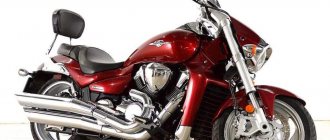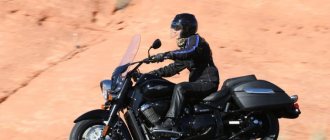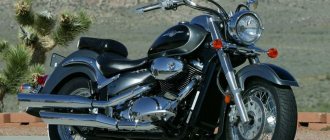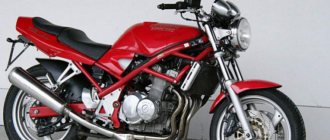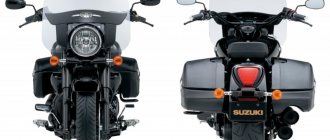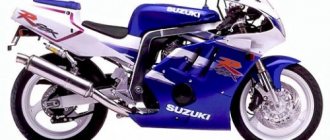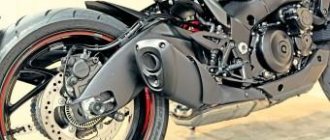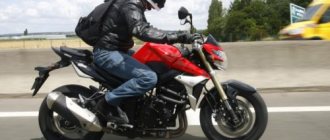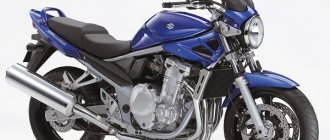| Suzuki Boulevard 400 (2005-2009) | Suzuki Boulevard 400 (2010-2016) |
Suzuki Boulevard 400 cruiser model
produced from March 18, 2005 until 2021 inclusive for the domestic Japanese market. The model was based on the older export version of the Suzuki Intruder M800 (Boulevard M50) with a simpler carburetor engine from the Suzuki Intruder VL400 Classic. The Suzuki Boulevard 400 model positions itself as a replacement for the obsolete Suzuki Desperado 400.
The Suzuki Boulevard 400 engine is a liquid-cooled 2-cylinder V-block with a capacity of 399 cc. see, producing 33 hp. power and 33 Nm of torque. Maximum motor performance is achieved at 6000-8000 rpm.
Otherwise, the Suzuki Boulevard 400 is almost completely identical to the older version of the M800 - a steel frame, suspension in the form of an inverted fork at the front and a monoshock at the rear, front disc and rear drum brake, 5-speed gearbox and cardan drive.
Main generations of Suzuki Boulevard 400:
- 2005-2009 - first generation.
- 2010-2016 - second generation.
Read more about the differences between the first and second generations, as well as technical changes over the years, in the “Brief history of the model” section.
2016 was the final year of production of the Suzuki Boulevard 400 in Japan. This motorcycle is quite rare on the Russian market and is in low demand due to its high price and modest technical characteristics. The main offers of the model on the market come from dealers who import equipment from auctions in Japan.
Brief history of the model
- March 18, 2005 - official launch of the Suzuki Boulevard 400 model. First generation.
Model:
Suzuki Boulevard 400 (Japan).
Frame number:
VK55A-100001 to VK55A-100431.
Factory designation:
VZ400K5, BC-VK55A.
- August 19, 2006 - no significant changes. This year's models are marketed as 2007 models (K7).
Model:
Suzuki Boulevard 400 (Japan).
Frame number:
VK55A-100432 to VK55A-100591 (VZ400K7), VK55A-100592 to VK55A-100693 (VZ400ZK7).
Factory designation:
VZ400K7, VZ400(Z)K7, BC-VK55A.
- September 2007 - no significant changes. This year's models are marketed as 2008 (K8) models.
Model:
Suzuki Boulevard 400 (Japan).
Frame number:
VK55A-100694 to VK55A-100698 (VZ400K8), VK55A-100699- (VZ400ZK8).
Factory designation:
VZ400K8, VZ400(Z)K8, BC-VK55A.
- November 2008 - due to the update of environmental emissions standards, the Suzuki Boulevard 400 model receives an injector instead of carburetors. This year's models are marketed as 2009 (K9) models.
Model:
Suzuki Boulevard 400 (Japan).
Frame number:
VK57A-100001 to VK57A-100170 (VZ400K9, VZ400ZK9).
Factory designation:
VZ400K9, VZ400(Z)K9, EBL-VK57A.
- March 3, 2010 - second generation. Like the older models (Boulevard M50 and Intruder M800), the Suzuki Boulevard 400 is being restyled - the shape of the wings and tank changes, and a small headlight fairing appears. The model receives the visual features of the Boulevard M109R.
Model:
Suzuki Boulevard 400 (Japan).
Frame number:
VK57A-100171- (VZ400L0).
Factory designation:
VZ400L0, BC-VK57A.
- 2011 - no significant changes. Factory designation:
VZ400L1, BC-VK57A. - 2012 - no significant changes. Factory designation:
VZ400L2, BC-VK57A. - 2013 - no significant changes. Factory designation:
VZ400L3, BC-VK57A. - 2014 - no significant changes. Factory designation:
VZ400L4, BC-VK57A. - 2015 - no significant changes. Factory designation:
VZ400L5, BC-VK57A. - 2016 - no significant changes. Last year of production. Factory designation:
VZ400L6, BC-VK57A.
Main generations of Suzuki Boulevard 400:
2005-2009 - first generation.
2010-2016 - second generation.
Read more about the differences between the first and second generations, as well as technical changes over the years, in the “Brief history of the model” section.
2016 was the final year of production of the Suzuki Boulevard 400 in Japan. This motorcycle is quite rare on the Russian market and is in low demand due to its high price and modest technical characteristics. The main offers of the model on the market come from dealers who import equipment from auctions in Japan.
Specifications
Technical characteristics of Suzuki Boulevard 400:
| Model | Suzuki Boulevard 400 |
| Motorcycle type | cruiser |
| Year of issue | 2005-2016 |
| Frame | steel tubular |
| engine's type | 2-cylinder, 4-stroke, V-shaped |
| Working volume | 399 cm³ |
| Bore/Stroke | 65.0 x 60.2 mm |
| Compression ratio | 10,5:1 |
| Cooling | liquid |
| Number of valves per cylinder | SOHC, 4 valves per cylinder |
| Fuel supply system | carburetor, 2x Mikuni BDSR29 – VZ400K5-K8 injector – VZ400K9+ |
| Ignition type | transistor |
| Maximum power | 33 hp at 8000 rpm |
| Maximum torque | 33 Nm at 6000 rpm |
| Clutch | Multi-disc in oil bath, cable drive |
| Transmission | 5-speed |
| type of drive | cardan |
| Front tire size | 130/90-16 |
| Rear tire size | 170/90-15 |
| Front brakes | 1 disc, 300 mm, 2-piston caliper |
| Rear brakes | drum |
| Front suspension | inverted fork, travel - 140 mm |
| Rear suspension | pendulum with monoshock absorber (adjustable preload), stroke - 105 mm |
| dimensions | 2370 x 920 x 1125 mm - Boulevard 400 (2005-2009) 2395 x 890 x 1105 mm - Boulevard 400 (2010-2016) |
| Wheelbase | 1655 mm |
| Seat height | 700 mm |
| Minimum ground clearance | 140 mm |
| Gas tank capacity | 17 l — VZ400K5-K8 15 l — VZ400K9+ |
| Maximum speed | 150 km/h |
| Acceleration 0-100 km/h (0-60 mph) | 9.5 sec. |
| Motorcycle weight | 240 kg - dry 267 kg - loaded |
Reviews
Reviews of Suzuki Boulevard 400:
Expand Collapse
All the disadvantages are in the engine itself. On the highway it doesn’t go more than 140, but at 120 it starts to blow away completely. It's hard to overtake, especially when the truck goes a hundred, try to overtake it again. I ride around the city more, and I think it’s great here. The steering wheel is not wide, it's fine in traffic jams.
In the first year of ownership, I drove from Moscow to Odessa, there was still some repairs along the road, there was gravel instead of asphalt. Suzuki Bolvard showed himself to be excellent, though his lower back got tired from time to time.
In the second year I decided to travel even further: Moscow - Finland - Germany - France - Switzerland - Germany - Poland - Ukraine (Odessa). Nothing like a minibus, right?
Well, I’ll say right away that for me the German autobahns were a sad sadness. I’m driving in the right lane, and where possible even empty trucks overtook me, and motorcycle brothers on sports cars rushed past and looked at me sympathetically in the side mirrors (I hope so).
Plus in reliability, during all this time nothing broke. Change the oil and filter and you will be happy. In my case this is true.
I also have the 400 for the third season, the consumables are the same as on the M 50, I have a 2005, the customs document and passport say Suzuki Intruder VZ400K, it is only for the Japanese domestic market, I am very pleased, I have had a lot of mileage in Europe, yes 400 cc It’s not enough for the autobahn, the poor fellow is struggling, and the French gendarmes giggle when they look at their passport.
text from MotoReview No., 2008
: Vladimir Zdorov, photo: Dmitry Ivaikin
Honda Steed 400VLC: 398 cm3, 31 hp, 211 kg, 1998, RUB 132,000. Suzuki 400 Intruder Volusia: 399 cm3, 32 hp, 237 kg, 2002, RUB 164,000.
Laws of dialectics
And, in fact, why not? I was recently told here that the world consists of more than just sportbikes, damn, who would have thought! Moreover, I confess, in my distant adolescence I had a dream, which, however, never came true... About a large, harsh motorcycle, always black, with an ornate horned steering wheel, with a “gynecologist’s appointment” seating position and with a male muffler, a dream any nymphomaniac. A reminder of the unfulfilled fantasy of a timid young man is the deadly heavy “leather jacket”, which occupies almost half of the entire closet, which, in an amicable way, would have been thrown out long ago, but the hand does not rise. It’s just that back then there weren’t such offers on the market, just as, in fact, there wasn’t even a market for motorcycles used by fans of Pokemon and algae... But now there is. Do you want an almost exact copy of H.-D. Street Bob, and even with a lever-spring (parallelogram) front fork? Or maybe you prefer a clone of the H.-D modification. Fat Boy? At the same time, the budget should not exceed, well, say, 160,000 rubles? Please – Honda Steed 400VLC and Suzuki 400 Intruder Volusia are already waiting for their buyers. And while the latter is still wandering around somewhere, it’s time to try to understand what both of these motorcycles are. Looking at the complex mechanism of the Honda front fork with disbelief, I decided to give it to a colleague at first, and in return received a fat guy, bloated with self-importance - a Suzuki 400 Intruder Volusia. It’s funny to sit almost on the ground, looking at the front wheel somewhere in front, but this is just a cost of permanent stay on sportbikes, a matter of time and habit. Usually, after about two hours you begin to feel quite natural on almost any motorcycle, except that this does not apply to scooters. In this connection, it should be noted that there were absolutely no complaints about the ergonomics of both Honda and Suzuki. Despite the modest cubic capacity, both motorcycles were built quite “adult-style”. Everything is very serious - thick muffler pipes, wide donuts of rear tires, an inexperienced viewer will not have even a shadow of doubt that these are at least 1000 cc vehicles. It's no surprise that in this segment, 90% of market success depends solely on design.
So, we either have a classic version of a chopper with a narrow front wheel and a small donut at the back, respectively, a Honda Steed, or we get a completely different type - in America it has a lot of different definitions - from “cruiser” to “classic motorcycle” (wow they are so “classic”, heh...). For example, it seems to me that the “bobber” option is very suitable for the Suzuki Volusia. Just don’t need hundreds of stones thrown into my garden - I know very well that this definition applies to other representatives of chopper-shaped animals, I just liked the word. In terms of dynamics, both devices are approximately equal, up to 80 km/h there is some “movement”, which gradually fades away at around 120 km/h - it is not proper for the owners of such motorcycles to become like “plastic” ones rushing straight to hell. The higher gears here are quite “working”, but due to the small displacement of the engines, if you need any sudden acceleration or even ordinary “sluggish” overtaking, you won’t be able to “sit out” on them - you will have to push “down”. Although switching to third in both the Honda and Suzuki cases will not give the desired increase in acceleration - rather, the engine noise will simply increase, so fourth gear is more suitable for displaying “aggression” on both devices. Traditionally, for such motorcycles, the space allocated for the passenger is rather arbitrary. But in our particular case, this does not apply to Suzuki - there is more than enough space for the “second number”. Another difference worth noting is the lower ground clearance of the Honda, which forces you to slow down almost to zero before every speed bump or just before ordinary bumps and wait with bated breath for the heartbreaking grinding sound under the sagging (that’s the idea) belly of the motorcycle.
Returning to the topic of size, it is important to note that the Suzuki Volusia, despite its 400cc format, is a full-size copy of its larger siblings. But on a Honda, people above average height may have certain problems, not so much with ergonomics (everything is in perfect order here), but with aesthetics, with the destruction of the image of a stern conqueror of long roads. The fact is that the average Russian, although he does not fall under the Hollywood template of a two-meter destroyer of decaliters of vodka, is still quite different in size from the one and a half meter Japanese, and in a jump and in a ski cap. In this connection, fairly large fellow citizens will look frankly comical at Honda; people are unlikely to be able to appreciate their subtle, aesthetic choice. Such gentlemen have a direct road to the Suzuki camp. All things being equal, the Volusia gives the feeling of being “more of a motorcycle.” Now the time has come to write about, in general, a part of the test that is by no means the main one in our case - that is, about dynamic indicators, in this category the priorities are set differently... Perhaps the rarest case when no noticeable effort was required from me to determine the leader. Both counterparts for quite a long time and sadly gain 130 km/h. Moreover, this is practically the limiting capabilities of the engines. Interestingly, if you are patient, both Honda and Suzuki can eventually demonstrate a “killer” 140 km/h. According to the speedometer... Thus, we can talk about a real maximum speed of 125–130 km/h. But, believe me, you will never want to do this, unless you are a test pilot for a motorcycle publication. Even out of idle curiosity. And the point here is not so much that in such modes both engines actually operate beyond their capabilities, although this is by no means an important factor. It just gets downright scary. The “rubber” chassis of both vehicles are not designed for such rates of movement. Honda and Suzuki are wagging their backs, living their own lives, trying in every possible way to reason with the “activist” who has lost his sense of smell, who has become somewhat overplayed as a tester and has finally left the image of a permanently beer-sipping biker. Imagine a marking line that usually runs along the dividing barrier on the Moscow Ring Road (however, not necessarily only there). So, on both the behemoth-shaped Suzuki and the graceful Honda, at the moment of its intersection, you feel with literally every vertebra exactly where and how many times first the front and then the rear wheel slipped, and how much this “terrible” obstacle caused the rear pendulum to bend along with the frame . If such warnings do not help, then both devices have a weapon that works 100% in such cases - brakes that were dead from birth. That's when it really gets scary! And don’t tell me that this is normal for choppers! I know a lot of other models of this class, where the brake mechanisms can easily give a head start to other sportbikes. And if mediocre handling together with cargo dynamics (you still need to understand that we are talking about 400cc machines) can somehow be attributed to a feature of this class of motorcycles, then such sluggish brakes are already serious. As for vibration load, both current duelists performed approximately equally well. In other words, up to the same, apparently textbook 80–90 km/h for choppers, everything is more than acceptable, but as soon as this value is exceeded, a few fillies begin to strain all their strength, in a vain attempt to show at least some speed. Naturally, nothing good comes of this, hence the vibrations. In general, as was noted at the very beginning of the article, you should look for happiness in dynamics on some other motorcycles. Here, in general, you need to be damn calm in character in order to start getting at least minimal pleasure. After all, even if you “puke” at the proper 90 km/h, there is always a big risk of getting a friendly blow to the tailbone, even on small bumps. And the point is not at all that the suspension is faulty, this is the price to pay for the peculiarities of the landing and its microscopic movement. However, things are noticeably more pleasant with the front fork. Moreover, oddly enough, the fashionable Honda mechanism showed itself to be much better than the classic Suzuki telescope with the thickness of the supporting pipes of such a small diameter that it seems that they can bend even from a slight wind.
Beauty versus practicality
The result is approximately the following picture. The Honda Steed is lighter and sleeker, especially when placed next to the somewhat overweight, slightly behemoth-like Suzuki. The price to pay for this is lower ground clearance than the competitor's and worse living conditions for the passenger. Also, the volume of the gas tank fell victim to beauty, which ultimately does not hold even 10 liters of fuel - with more or less active driving, repeated daily refueling is guaranteed. As a result, the motorcycle for travel is not the best, its habitat is the city, and its future owner should either be no taller than average height, or... a completely abstract individual indifferent to the opinions of others. As a reward, he will receive a very stylish motorcycle, the front fork alone is worth it. As for the rather limited practicality - well, beauty has never been free... Suzuki Volusia seems to me like a strong middle peasant, albeit without the gloss of a Honda Steed, but with a normal-sized seat and a capacious gas tank. It is also important that on Suzuki there are no strict restrictions on the rider’s build. In general, there is nothing new in this world - beauty has always been far from mundane practicality...
